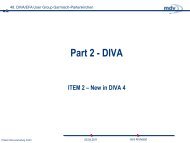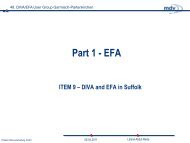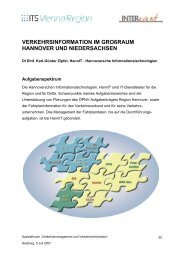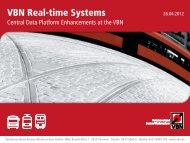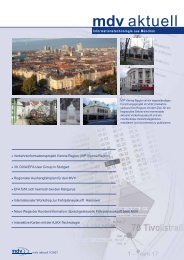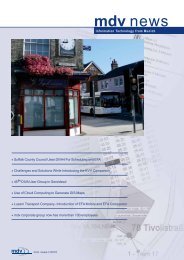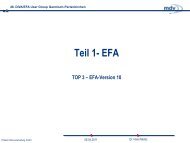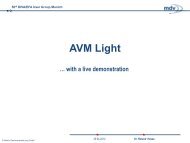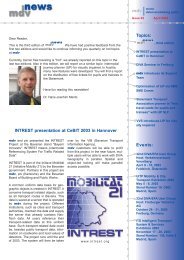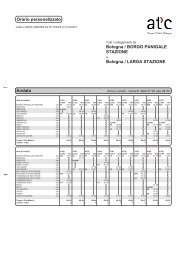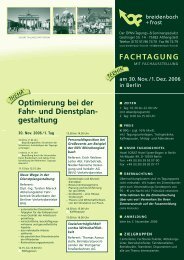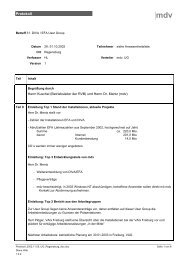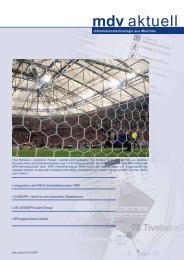Multi-modal Trip Planning for the San Francisco Bay Area - Mentz ...
Multi-modal Trip Planning for the San Francisco Bay Area - Mentz ...
Multi-modal Trip Planning for the San Francisco Bay Area - Mentz ...
You also want an ePaper? Increase the reach of your titles
YUMPU automatically turns print PDFs into web optimized ePapers that Google loves.
4 mdv news I/2011<br />
Figure 1: Management of traffic alerts received by<br />
DATEX2 in <strong>the</strong> ICS<br />
Figure 2: Integration of traffic alerts into <strong>the</strong> directions<br />
(shown in a test layout)<br />
Mapping Static and Dynamic Traffic Data<br />
A challenge when integrating traffic alerts and<br />
o<strong>the</strong>r in<strong>for</strong>mation relevant <strong>for</strong> IT-routing is <strong>the</strong><br />
various reference graphs. This problem was also<br />
confronted when developing <strong>the</strong> multi-<strong>modal</strong><br />
trip planner <strong>for</strong> <strong>the</strong> <strong>San</strong> <strong>Francisco</strong> <strong>Bay</strong> <strong>Area</strong>. Both<br />
<strong>the</strong> traffic alerts and <strong>the</strong> speed profiles are referenced<br />
to a network graph which is not identical<br />
to <strong>the</strong> network graphs of <strong>the</strong> multi-<strong>modal</strong><br />
trip planner. As a consequence, <strong>the</strong> additional<br />
in<strong>for</strong>mation cannot be accounted <strong>for</strong> when<br />
calculating car routes without converting<br />
location references.<br />
The GisImport and DivaGeo modules had to be<br />
enhanced to calculate a conversion table<br />
between two network graphs and feed <strong>the</strong> output<br />
into an ASCII file. This table is subsequently<br />
read by <strong>the</strong> ICS and ITProfileConverter applications<br />
and used to convert location references.<br />
As depicted in Figure 4, traffic alerts or characteristics<br />
cannot be displayed on ano<strong>the</strong>r network<br />
graph without a conversion table. Using<br />
<strong>the</strong> conversion table it is possible to show in<strong>for</strong>mation<br />
on <strong>the</strong> red line on one or more of <strong>the</strong><br />
green lines. Consequently, traffic alerts and<br />
speed values from <strong>the</strong> profiles can be integrated<br />
into <strong>the</strong> multi-<strong>modal</strong> trip planning<br />
portal without any loss of in<strong>for</strong>mation.<br />
Time-bound Tolls<br />
A fur<strong>the</strong>r challenge to be overcome was <strong>the</strong><br />
integration of time-bound tolls, which are specific<br />
to car routing in <strong>the</strong> <strong>Bay</strong> <strong>Area</strong>. All trips over<br />
<strong>the</strong> bay bridges of <strong>San</strong> <strong>Francisco</strong> require tolls in<br />
at least one direction and some tolls are even<br />
dependent on <strong>the</strong> time of day travelled and<br />
payment method used (cash or automatic easy<br />
pass). The data model of <strong>the</strong> dynamic IT algorithm<br />
was enhanced <strong>for</strong> this requirement and<br />
<strong>the</strong> directions now indicate <strong>the</strong> tolls due based<br />
on payment method and time of day.<br />
Scenario 3: Drive&Park and Kiss&Ride<br />
The last trip scenario <strong>for</strong> a comparison is<br />
requesting a Drive&Park or Kiss&Ride route over<br />
<strong>the</strong> multi-<strong>modal</strong> trip planning portal. In doing<br />
so, <strong>the</strong> EFA system ei<strong>the</strong>r automatically selects<br />
<strong>the</strong> best Drive&Park parking spaces or lets users<br />
choose a desired transition point <strong>for</strong> a<br />
Drive&Park or Kiss&Ride trip from a list of<br />
options.<br />
Figure 4: Mapping between two network graphs<br />
Parking Garages and Drop-off Points<br />
The parking garages and drop-off points <strong>for</strong> a<br />
Drive&Park or Kiss&Ride trip are converted into<br />
GIS data using <strong>the</strong> GISImport application. The<br />
parking garages and transition points constitute<br />
a new point layer in <strong>the</strong> GIS data that can<br />
be used save additional attributes relevant <strong>for</strong><br />
parking. Among o<strong>the</strong>r things, <strong>the</strong> number of<br />
parking spaces, <strong>the</strong> coordinates of <strong>the</strong><br />
entrances and exits, <strong>the</strong> average duration<br />
between entering and leaving <strong>the</strong> parking<br />
garage and o<strong>the</strong>r numerous in<strong>for</strong>mative attri -<br />
butes per parking garage are imported and<br />
saved in <strong>the</strong> GIS data.<br />
This in<strong>for</strong>mation can be subsequently integrated<br />
into <strong>the</strong> EFA system and requested with<br />
assistance from <strong>the</strong> EFAParkingServer (see Figure<br />
6). In order to automatically pre-select <strong>the</strong><br />
best Park&Ride parking spaces, <strong>the</strong> system uses<br />
an escalating proximity search. If no parking<br />
garages are found within a starting radius of 5<br />
miles around <strong>the</strong> trip origin, <strong>the</strong> search is incrementally<br />
widened until it reaches an indicated<br />
maximum.<br />
Automatic Selection of <strong>the</strong> Best Drive&Park<br />
Routes<br />
In <strong>the</strong> past, users were <strong>for</strong>ced to select from a<br />
list with preselected parking garages, be<strong>for</strong>e<br />
<strong>the</strong> EFA system could calculate and present a<br />
complete Drive&Park trip. This manual selection<br />
is now complemented in <strong>the</strong> multi-<strong>modal</strong> trip<br />
planning portal <strong>for</strong> <strong>the</strong> <strong>San</strong> <strong>Francisco</strong> <strong>Bay</strong> <strong>Area</strong><br />
by an automatic selection of <strong>the</strong> best<br />
Drive&Park routes <strong>for</strong> an indicated departure or<br />
arrival time.<br />
As depicted in Figure 5, <strong>the</strong> process of automatically<br />
selecting <strong>the</strong> best Drive&Park routes is a<br />
complex orchestration of <strong>the</strong> various EFA components.<br />
It begins with verification of trip origin<br />
and destination (EFALocationServer), continues<br />
with a search <strong>for</strong> Drive&Park parking spaces<br />
near <strong>the</strong> starting point of <strong>the</strong> trip (EFAParkingServer),<br />
a search <strong>for</strong> public transport stops<br />
near <strong>the</strong> parking spaces and close to <strong>the</strong> destination<br />
(EFAGISKernel), calculation of footpaths<br />
between parking garages and origin stops,<br />
between destination stops and <strong>the</strong> final trip<br />
destination (EFAITRoutingKernel) and <strong>the</strong>



